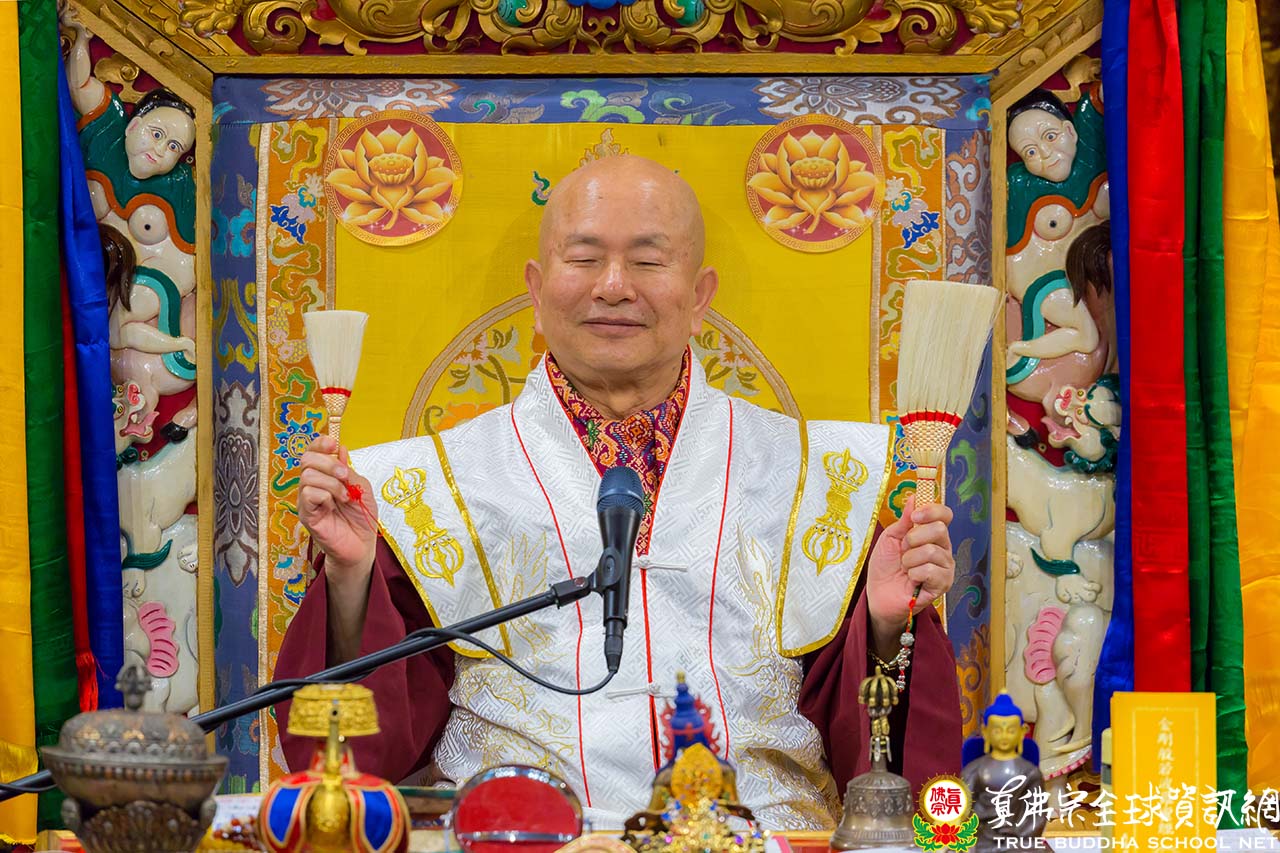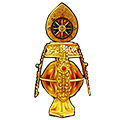Vajracchedika Prajnaparamita Sutra
Vajra Sutra (Diamond Sutra)
Detailed Exposition by Living Buddha Lian-Sheng, Grandmaster Sheng-yen Lu
Translated into English by True Buddha School Vajra Sutra Translation Team
Discourse 21, 3 October 2021 - Chapter Seven—Nothing Gained, Nothing Spoken (continued)
Seven—Nothing Gained, Nothing Spoken
“Subhuti, what do you think? Does the Tathagata attain anuttara samyaksambodhi? Does the Tathagata speak on the dharma?”
Subhuti replied, “In my understanding of the meaning of the Buddha’s teaching, there is no fixed dharma called anuttara samyaksambodhi, and there is no fixed dharma spoken by the Tathagata. Why? Because all teachings of the Tathagata cannot be held and cannot be spoken. They are not dharma, and they are not non-dharma. Therefore, all sages are distinguished by effortless motiveless dharma.”
Now we will expound on the Vajra Sutra. We will expound Chapter Seven—Nothing Gained, Nothing Spoken.
During my practice last night, Golden Mother told me, “What you talked about last night was quite vague. Not everybody understood, only a few people understood it. You must clarify.” I said, “Even if I repeat it, they still will not understand.” [Grandmaster is laughing.] She said, “You need to use analogies to explain.” Sakyamuni Buddha likes to use similes when giving dharma teachings.
Yesterday, I talked about anuttara samyaksambodhi. What does it mean? “Does the Tathagata attain anuttara samyaksambodhi? Does the Tathagata speak on the dharma?” Subhuti replied, “In my understanding of the meaning of the Buddha’s teaching, there is no fixed dharma called anuttara samyaksambodhi.” This is correct. When you become a bodhisattva, you would not think you are a bodhisattva. If you often think that you are a bodhisattva, then you “hold” something; it’s that easy. When you attain anuttara samyaksambodhi, you don’t constantly tell everyone that you have attained anuttara samyaksambodhi. You would not say such thing. If you proclaim that you have attained anuttara samyaksambodhi, [that only indicates that] you have not attained it. Those who truly have attainment will not say it. A bodhisattva will not say that he is a bodhisattva. He is already a bodhisattva, he does not need to say that he is a bodhisattva. Do you understand? I will tell you that this is simply what the Buddha meant.
Because all teachings of the Tathagata cannot be held and cannot be spoken. They are not dharma, and they are not non-dharma. Yesterday we talked about not dharma and not non-dharma. We now understand “not dharma,” but we don’t know about “not non-dharma.” I explained yesterday that not non-dharma means that there seems to be dharma, and there seems to be non-dharma. But Golden Mother said, “That is too vague!” What is too vague? Golden Mother told me, “Logic. Remember, this is logic.” Not dharma and not non-dharma; I will explain it clearly now.
If we study logic, we should know. A white horse is a horse, correct? So a horse is a white horse, is that correct? Wrong! It’s right that a white horse is a horse, but a horse is not a white horse. Do you understand this? This is logic. Golden Mother told me to explain using logic to make it understandable.
What is not non-dharma? Generosity is buddhadharma, but buddhadharma is not generosity. To say this is right. To say that buddhadharma is generosity is wrong. [By the same logic, we say that] not non-dharma is buddhadharma is wrong. Not non-dharma seems like buddhadharma but it is not buddhadharma. Buddhadharma itself is too vast to explain.
I went to the main chapter in Kaohsiung, Taiwan giving dharma teachings and I said, “Tzu Chi is buddhadharma, but buddhadharma is not Tzu Chi.” There is someone from the Tzu Chi Foundation who stood up and said, “Grandmaster, you are wrong! Tzu Chi is buddhadharma, buddhadharma is Tzu Chi!” I told him, “You go back and ask Master Chengyen.” Master Chengyen is my elder dharma sister. Really, I am not lying. She is a disciple of Master Yinshun and so am I. She is older than I am and I can call her dharma sister, right? Right. Master Mingsheng is her dharma uncle, and he lived next to my house in Taiwan—a townhouse in the Jingwu Villa, which shared the same wall with Master Yinshun. I lived in the house further in and Master Yinshun and his personal attendant Master Mingsheng lived in the house further out, it was called Huayu Vihara of Master Yinshun. We called Mingsheng dharma uncle. We knew each other very well.
Please remember the explanation that Golden Mother told me regarding the not non-dharma. The analogy is: generosity is buddhadharma, but buddhadharma is not generosity. Endurance is buddhadharma, but buddhadharma is not endurance. Because buddhadharma is vast, right? Everything is buddhadharma and anything you point is buddhadharma. But, if you say that buddhadharma is [just] endurance, that’s wrong. This is the explanation of the not non-dharma. It’s buddhadharma, but it’s also not buddhadharma. This explanation is taught by Golden Mother, it’s very easy to understand, it’s logical. A white horse is a horse, but a horse is not a white horse. Why? Because there are white ones, black ones, brown ones, multi-colored ones and all different types of horses. There is now also grass mud horse created in Taiwan [a play of word, “Cao ni ma” is a curse word but is also used to refer to an alpaca]. What is going on? Jeannie Hsieh is a singer who should just sing, instead she got on stage riding on an alpaca. There is also an artist in Taiwan called Ma Guobi, right? [laughter] Why? How come he picked such a name? And Jennie didn’t pick any other horse but an alpaca! Really! [chuckling]
Golden Mother told me there was another part that was also unclear. Therefore, all sages are distinguished by effortless motiveless dharma. How do you explain this? Golden Mother told me that a bodhisattva is a sage, correct? All of Four Holy Realms are sages; arhats, pratyekabuddhas, bodhisattvas and buddhas are all sages. Let’s take bodhisattvas as an example. A bodhisattva is a sage by means of effortless motiveless dharma. A bodhisattva cultivates effortless and motiveless dharma. He acts without any motive and he just does it [effortlessly]. What is effortless motiveless dharma? Doing but not because of anything. I just do it in accordance with the bodhicitta of a bodhisattva. A bodhisattva generates bodhicitta in all their actions. When I act with no motive other than bodhicitta, then that is effortless motiveless dharma.
Are there differences? Yes, there are differences among the bodhisattvas. The first ground bodhisattva is called the ground of joy, then there is the ground of radiant intellect. The seventh ground bodhisattva is the ground of gone afar; the tenth ground bodhisattva is called the ground of the cloud of dharma. There are different grounds of bodhisattvas, from the first to the tenth. The first ground bodhisattva, the second ground bodhisattva, the third ground bodhisattva, the fourth ground bodhisattva, the fifth ground bodhisattva, the sixth ground bodhisattva, the seventh ground bodhisattva, the eighth ground bodhisattva, the ninth ground bodhisattva, and the tenth ground of bodhisattva are differentiated by how far their effortless motiveless dharma is. This is how they are different. You are a bodhisattva of which ground?
Golden Mother told me to speak on it clearly. All sages are distinguished by effortless motiveless dharma. Bodhisattvas have different grounds of attainments, so do in arhatship. They have different levels of attainment. I will talk about it later. the Vajra Sutra will also mention it. The arhat is the highest of arhatship. Arhatship has four levels: arhats living in samsara [stream-enterer], arhats with one more return before becoming arhats [once-returner], non-returning arhats in the non-returning heavens [non-returner] and the sagely arhats. Those are the four level of arhatship, and there are differences among them.
There are also differences among the buddhas. The Primordial Buddha is at the sixteenth ground, the Five Dhyani Buddhas are at the thirteenth ground. The Thousand-eyed Thousand-armed Avalokitesvara Bodhisattva is also equivalent to a buddha and is at the eleventh ground. He has eleven faces with Amitabha Buddha’s face at the highest, and he’s also referred to as the Eleven-faced Avalokitesvara. He is a buddha of the eleventh ground. All sages are distinguished by effortless motiveless dharma. Now, is this clear? [The audience is clapping.] This is my exposition on Chapter Seven—Nothing Gained, Nothing Spoken. What I expounded last night was not clear enough. Golden Mother told me to explain again so you understand.
Om mani padme hum.
Version 2021.11.3





